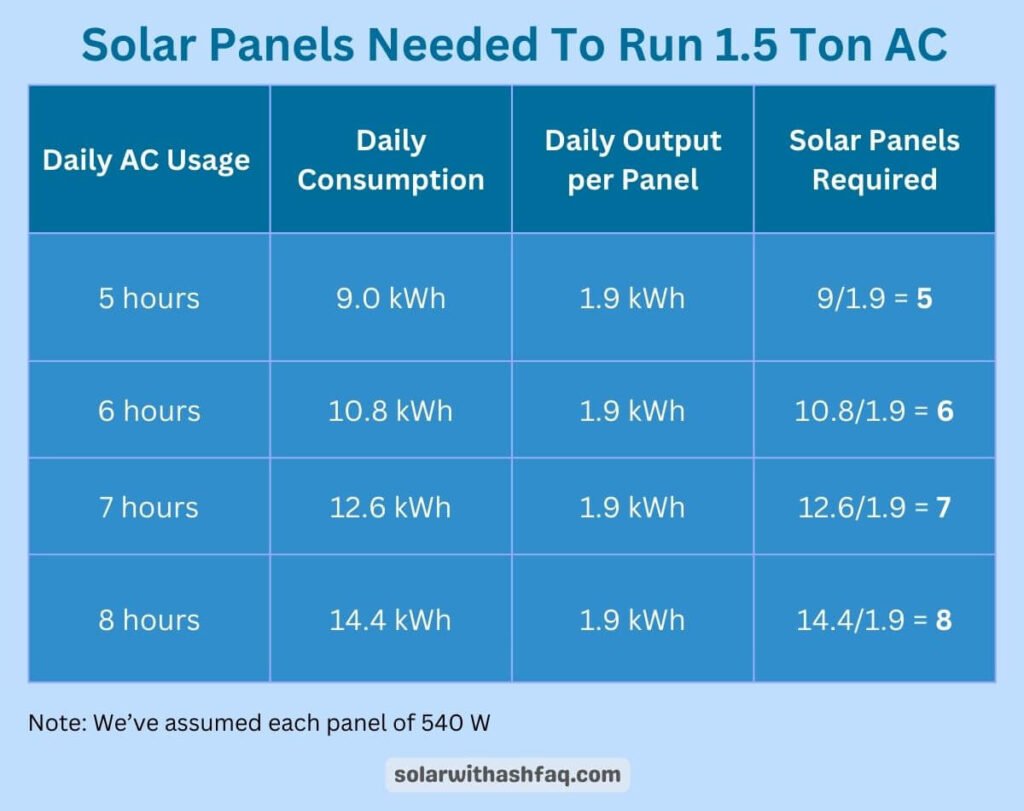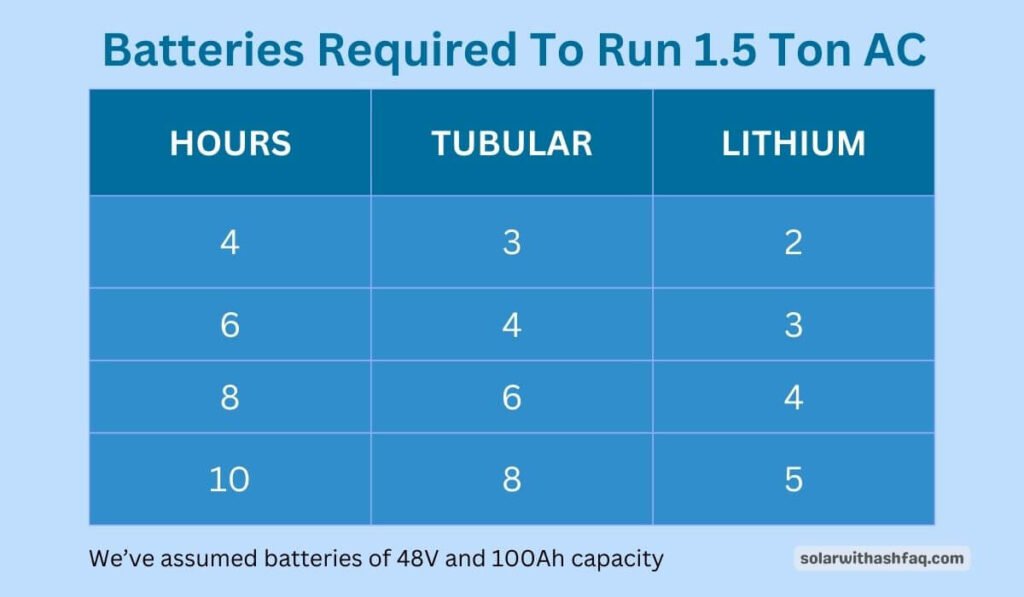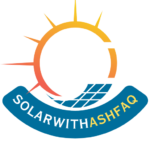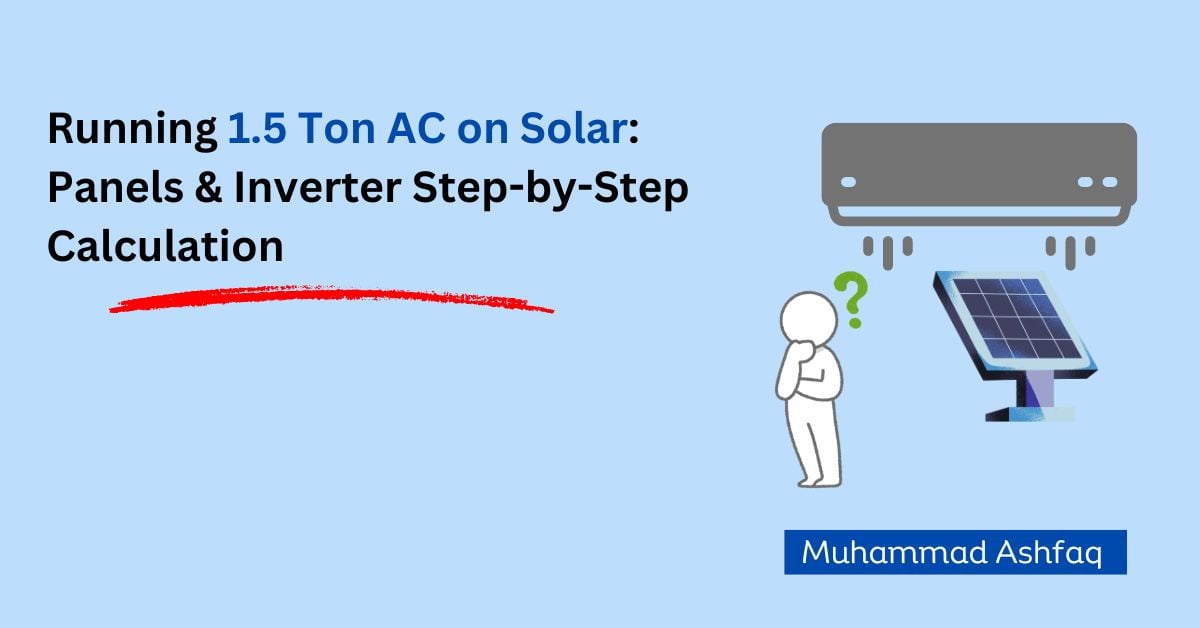Running 1.5 Ton AC on Solar: Panels & Inverter Step-by-Step Calculation
The most demanding question these days in Pakistan is, how many panels are needed to run 1.5 Ton AC?
First, understand that its answer is not like ONE plus ONE is equal to TWO, as there are many variables involved in the calculation like constantly changing sunlight, how many hours you will use AC, and available peak sun hours in your area.
That being said, we’ll take care of all these factors in our calculations.
If you prefer watching videos over reading, check out this video instead.
Find Trusted Solar Companies in Your City
No more guesswork! Compare expert-approved solar companies to safe-guard your investment.
Power Requirements of a 1.5-Ton AC
1 Ton is the unit of thermal heat, not electric power. So, What is the power requirement for a 1.5-ton air conditioner in Watts? Let me break it down for you in a way that’s easy to understand.
A 1-ton air conditioner (AC) has a cooling capacity of 12,000 British Thermal Units (BTUs) per hour.
Now, when it comes to power consumption, a typical 1.5-ton inverter AC unit in Pakistan will use around 1,800 watts (1.8 kW) per hour.
This is a more energy-efficient option compared to a conventional (non-inverter) 1.5-ton AC, which can consume up to 2,400 watts (2.4 kW) per hour.
The difference in power consumption is due to the advanced technology used in inverter ACs. They can adjust their compressor speed to match the cooling demand, rather than running at a constant high speed like traditional ACs.
In our calculation, we’ll use an inverter AC having 1800 W power.
Also Explore: How Many Panels Needed For Air Cooler
Daily AC Usage
First things first, let’s talk about how long you plan to run your AC each day. Of course, the number of hours you run your AC will directly impact the size of the solar panel system.
More runtime means you’ll require a larger solar setup to meet your needs.
Assuming you want to run the AC for 5 hours a day, the total energy consumption would be
1.8 kW×5 hours = 9 kWh
Daily Usage = 9kWh
Daily Output Per Panel
Solar panels are rated in wattage, with common sizes ranging from 300W to 545W. But it’s important to keep in mind that solar panels don’t always perform at their full rated capacity.
In reality, they usually produce around 70% of their rated output due to various inefficiencies.
Now, let’s look at the average daily output you can expect. Assuming you get about 5 hours of effective sunlight per day (which is a reasonable estimate for many parts of Pakistan).
Here’s what you can expect with each panel of 540W:
540W x 70% x 5 hours = 1.9 kWh per day
Daily Panel Output = 1.9kWh
Number of Panels Required
To determine how many panels are needed, you can use the formula:
Number of Panels = Total Daily Consumption kWh / Daily Output per Panel kWh
Putting the above values we get:
Number of Panels = 9/1.9
Number of Panels Needed = 5

If you’re looking to understand the bigger picture — including system types, design strategies, and practical engineering considerations — explore Vecharged’s in-depth expert guide to running an AC on solar. It’s built to give you clarity, whether you’re a beginner or planning a serious install.
Ask ChatGPT
What Should be the Size of the Inverter to Run 1.5 Ton AC?
The solar inverter should handle continuous power rating and surge power of AC as elaborated below.
Continuous Power Rating
For an AC, the inverter should be rated at least for the running wattage.
So, the Minimum Inverter Size: is 2,000 watts (to provide a buffer for efficiency and additional loads).
But this rating is not enough to run the AC at the start of AC.
Surge Power Rating
Air conditioners require additional power at startup (surge power), which can be 3 to 5 times the running wattage. Therefore, the inverter should also be capable of handling this surge.
Surge Power = 1.8 kW×3 = 5.4 kW
So recommended inverter according to availability in the market:
Recommended Inverter Size = 3.5 kWh to 4 kWh
How Many Batteries Required for 1.5 Ton AC?
First, we have to work out the amount of current the batteries must supply to the air conditioner for it to run smoothly.
Note: Most solar setup batteries are 24V or 48V. For our calculations, we use 48V as it’s the most common.
Current Drawn by AC
Current = AC Power / Battery Voltage
Current = 1800 W / 48 V
Current = 37.5 A
Total Amp-Hours Required
To calculate this, we’ve to figure out how many hours we will run AC.
We take 8 hours:
Total Ah = 37.5 A × 8 hours
Total Ah = 300 Ah
Number of Batteries Required
Using 100 Ah batteries:
Number of Batteries = 300 Ah / 100Ah = 3
Remember, batteries are not discharged completely; they have a certain depth of discharge.
For example, tubular batteries are discharged to 50%, while lithium batteries can be discharged up to 80%.
So, to run 1.5 ton AC for 8 hours, we need at least 4 Lithium batteries or 6 Tubular batteries.
What about running the AC for different hours?
Check the table below for detailed coverage.

Additional Considerations
- Inverter Type: A pure sine wave inverter is recommended for running sensitive electronics like an AC to ensure compatibility and efficiency.
- Battery Lifespan: Lithium-ion batteries generally have a longer lifespan and faster charging times compared to lead-acid batteries.
- Efficiency Losses: Inverters typically have an efficiency rating of around 85-90%, so it’s essential to account for this when sizing the inverter.
Final Thoughts
The above steps are the most approximated and accommodated with all the factors.
Lastly, one Pro Tip: If you have enough cash in hand, then buy a solar air conditioner that makes the best use of solar energy.
Frequently Asked Questions
For a 1-ton inverter AC, you will need about 4 to 5 solar panels of 440 watts or 3 panels of 545 watts. A conventional 1-ton AC may require around 6 to 7 panels of 250 watts, depending on the specific model and its efficiency.
A 1.5-ton inverter AC uses around 1800 watts on average, while a conventional 1.5-ton AC consumes 2400 watts. Higher star-rated ACs are more efficient and consume less power.
Yes, you can run an AC directly from solar panels if you use solar air conditioners. For an inverter AC use a solar power system an inverter and batteries. This setup ensures a stable power supply and allows for energy storage for use during non-sunny periods.
A 3kW solar system can typically run one 1.5-ton inverter AC comfortably. Depending on the efficiency and power consumption of the AC units, it may also support a 1-ton AC along with smaller appliances, but running multiple high-wattage ACs simultaneously is generally not feasible.
Factors include the type of AC (inverter vs conventional), its energy efficiency rating, the wattage of the solar panels, average sunlight hours in your location, and the total power requirements of the system. Proper installation and panel orientation also play a crucial role in efficiency.

Content Writer | Assistant Manager (Electrical) at IESCO
As a passionate content writer, I’m on a mission to make solar hassle-free for you through my expert guides and easy-to-digest content.

